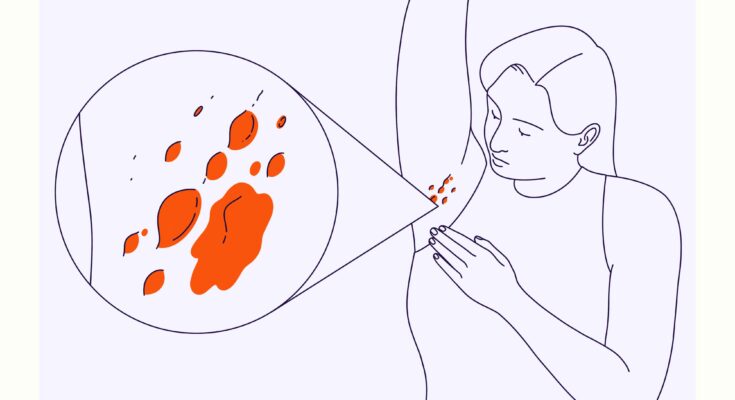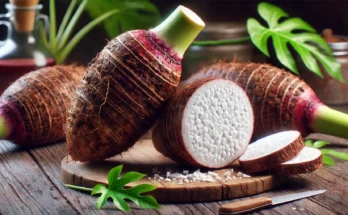Boils, also known as abscesses, are painful, swollen lumps that form under the skin due to bacterial infections. While they can develop in various areas of the body, the armpit is a common site due to its warmth, moisture, and the presence of sweat glands and hair follicles. Armpit abscesses, although not life-threatening, can cause discomfort and affect daily activities. In this article, we will explore the causes, symptoms, treatment options, and preventive measures for boils in the armpit area.
What Causes Boils in the Armpit?
A boil occurs when a hair follicle or oil gland becomes infected with bacteria, usually Staphylococcus aureus. The infection leads to the formation of a painful, swollen bump that may fill with pus. The armpit is particularly prone to boils due to several factors:
- Moisture and Sweat: The armpits are naturally damp, which creates an ideal environment for bacteria to thrive.
- Friction and Irritation: Tight clothing, shaving, or excessive rubbing can irritate the skin and make it more susceptible to infection.
- Blocked Pores: Sweat glands and hair follicles in the armpit can become clogged with dead skin cells or debris, leading to infection.
- Weakened Immune System: People with compromised immune systems (e.g., those with diabetes or autoimmune disorders) are at a higher risk of developing boils.
Symptoms of Armpit Boils
The symptoms of a boil typically begin with redness and swelling in the affected area. As the infection progresses, the bump may grow larger and become more painful. Common symptoms include:
- A firm, red bump under the skin.
- Pain or tenderness in the armpit.
- Pus or drainage from the boil if it ruptures.
- Fever (in severe cases).
- Swollen lymph nodes in the nearby area.
How Are Boils in the Armpit Treated?
Most boils in the armpit can be treated effectively at home, but more severe cases may require medical intervention. The treatment approach depends on the size, severity, and underlying health of the individual.
1. Home Remedies for Small Boils:
- Warm Compress: Apply a warm, damp cloth to the boil several times a day. This helps the pus to drain and reduces pain and swelling.
- Over-the-Counter Antibiotic Ointments: If the boil is small and not very painful, topical treatments containing antibiotics like Neosporin can be applied to prevent further infection.
- Pain Relief: Over-the-counter pain relievers such as ibuprofen or acetaminophen can help reduce pain and swelling.
2. Medical Treatment for Larger or Recurrent Boils:
If the boil does not improve with home care or if it becomes larger and more painful, medical treatment may be necessary.
- Incision and Drainage: A healthcare professional may make a small incision to drain the pus from the boil. This is often done under local anesthesia to minimize discomfort.
- Antibiotics: If the infection is severe or if there is concern about the spread of bacteria, oral antibiotics may be prescribed to clear the infection.
- Drainage Tube: In cases of large abscesses, a doctor may place a small drainage tube to allow the pus to continue draining over time.
3. Surgical Removal:
In rare cases where boils become recurrent or form a “boil cluster” known as hidradenitis suppurativa, a surgical procedure may be required to remove the infected tissue.
Preventing Boils in the Armpit Area
While not all boils can be prevented, there are several steps you can take to reduce your risk of developing them:
- Practice Good Hygiene: Regularly wash the armpit area with soap and water to reduce the buildup of sweat and bacteria.
- Avoid Tight Clothing: Wear loose-fitting clothes made of breathable fabrics to reduce friction and moisture buildup.
- Shave with Care: Use a clean razor and shave in the direction of hair growth to minimize irritation.
- Moisturize: Use a gentle, non-comedogenic moisturizer to keep the skin in the armpit hydrated and prevent clogged pores.
- Manage Sweat: Consider using an antiperspirant to reduce excessive sweating, which can create an environment conducive to bacterial growth.
When to See a Doctor
While many boils can be treated at home, there are times when medical attention is necessary. See a doctor if:
- The boil is large, extremely painful, or growing rapidly.
- You experience symptoms of systemic infection, such as fever, chills, or redness spreading from the boil.
- The boil keeps recurring or multiple boils develop.
- You have underlying conditions such as diabetes or a weakened immune system, which can increase the risk of complications.
Boils in the armpit area, while uncomfortable and unsightly, are usually treatable with proper care. From home remedies like warm compresses to professional treatments like incision and drainage, there are effective options available for managing this condition. By maintaining good hygiene, avoiding skin irritation, and seeking medical care when necessary, you can reduce your chances of developing boils in the future. Always consult a healthcare provider if you’re unsure about the severity of your symptoms or if your condition worsens.
If you’re experiencing recurrent boils or abscesses in the armpit area, it’s essential to discuss a comprehensive treatment plan with a dermatologist to manage and prevent further outbreaks.



